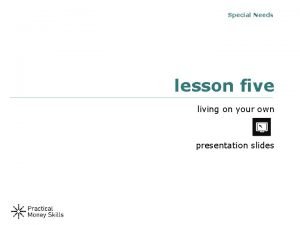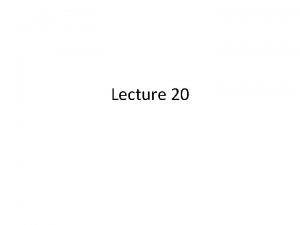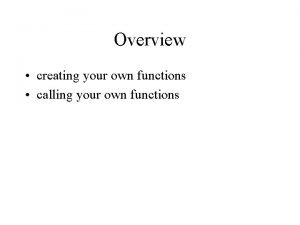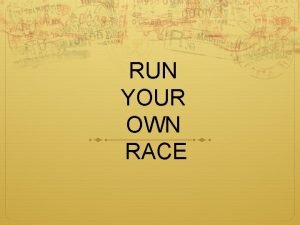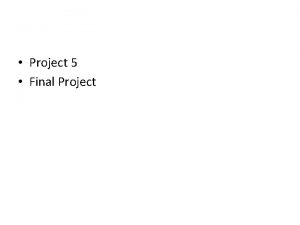Lecture 17 Final Project Design your own survey























- Slides: 23

Lecture 17

Final Project • Design your own survey! – Find an interesting question and population – Design your sampling plan – Collect Data – Analyze using R • Write 5 page paper on your results • Due April 21

Final presentation • During the last class (April 26) all students will be required to give a short presentation – Select one of the three projects – Make a powerpoint presentation (no more than 35 slides) – Present your results to the class

Final Project • Design your own survey! – Find an interesting question and population – Design your sampling plan – Collect Data – Analyze using R • Write 5 page paper on your results • Due December 1

Final presentation • All are required to give a short presentation • Last two classes (December 1 and 6) – Select one of the three projects – Make a powerpoint presentation (no more than 35 slides) – Present your results to the class

Statistics • Main ideas of statistics – Given multiple plausible models select one (or several) that is (are) the most consistent with the observed data – Quantify a measure of belief in our solution • The main idea is that if something looks like a very unlikely coincidence we would prefer another more likely explanation


Example 1 • There is one model we favor and want to check if a particular feature of the data is consistent with it (hypotheses testing). • The UK National Lottery is 6/49 Genoese lottery. – In the first 1240 drawings since 2000 there has been a lucky number 38 (drawn 181 times) and unlucky number 20 (drawn 122 times). [All things being equal we would expect each number to be drawn 151. 8] – Similarly number 17 took a staggering break of 72 drawings in a row! • Is this consistent with the assumption that the lottery is random and all numbers are equally likely?

Idea • Generate similar data from the known distribution and compare with the results observed. • Statistics: number of times “luckiest number” drawn, number of times “unluckiest number” drawn, size of the biggest gap

R simulation • Code Loterry 1240. R • What is our conclusion?

Example 2 • Premier League 2006/2007 – 20 teams – playing home and away (total 380 matches) – 3 points for victory, 1 point each for a draw – At the end Manchester United ended up with 89 points, Chelsea with 83, Watford with 28 • Could we view this as random • http: //plus. maths. org/content/understandinguncertainty-premier-league? src=aop

R simulation • Data – http: //en. wikipedia. org/wiki/2006– 07_Premier_League • Statistic – Max (89), min (28), variance (238. 7) • Issue – it is known that there is a big difference between home and away. – Simple model: (p-home, p-draw, p-away) • If all things were equal we can estimate this to be (48%, 26%) • Conclusion?

Other issues • In sports – successive trials are probably not independent • Can we test this? What would we need? – Data – Statistics (numerical measurement that caries information about the feature we are interested in) – Simulation scheme/model

Other statistical problems • Having several models and deciding how likely each model is given data. • Bayesian statistics – Need prior believe in each model – Update the believe based on data

Deciding between several models • One option is to use Bayesian approach

Bayesian statistics • A method for updating and combining information expressed in terms of probabilities (data and prior believes) • Recent notable uses – Nate Silver http: //fivethirtyeight. com – Search for Air France Flight 447 http: //en. wikipedia. org/wiki/Air_France_Flight_4 47

Example 1: • Testing for disease or drug. – Two models: • Subject has the disease (uses drugs) – Test is positive with probability q 1 (sensitivity) • Subject does not have the disease (is clean) – Test is negative with probability q 2 (specificity) – Prior information • Certain proportion p of the population has the disease

• It is claimed that a Drug. Wipe 5 has sensitivity of 91% and specificity of 95% • About 4% of the population uses • A randomly selected worker tested positive. – What is the chance he is a user? • http: //www. drugwarfacts. org/cms/Drug_Testi ng

Excel Calculation

• A spotter has a 30% success rate in spotting workers who use. A person selected by a spotter was tested positive. Is there a difference? • Comments?

The rule of succession • Derived by Laplace (1814) • We have an experiment that can end up in success or failure • We performed n experiments and all of them were successes. What is the chance that the next one will be success?

• Consider N models • Chance of success – p=0/(N-1), 1/(N-1), …, (N-1)/(N-1) • Observed data n out of n successes • Prior – all models equally likely • Posterior probability

Example 2 b • What if we observed s out of n successes? • Other priors?
 What type of sae is when you own your own business
What type of sae is when you own your own business Why is it difficult to get poison in mantua
Why is it difficult to get poison in mantua How to create your own species
How to create your own species Creating a society project
Creating a society project Your notebook define the following terms in your own words
Your notebook define the following terms in your own words Your conscious awareness of your own name
Your conscious awareness of your own name Create your own coat of arms
Create your own coat of arms 01:640:244 lecture notes - lecture 15: plat, idah, farad
01:640:244 lecture notes - lecture 15: plat, idah, farad Primary survey secondary survey
Primary survey secondary survey Give us your hungry your tired your poor
Give us your hungry your tired your poor Project procurement management lecture notes
Project procurement management lecture notes Software project management handwritten notes pdf
Software project management handwritten notes pdf Project quality management lecture notes
Project quality management lecture notes Project cost management lecture notes
Project cost management lecture notes Project management lecture
Project management lecture Project planning and management lecture notes ppt
Project planning and management lecture notes ppt How to create your own top level domain
How to create your own top level domain My own parable
My own parable How to write your own parable
How to write your own parable Making new words your own lesson 20
Making new words your own lesson 20 Dramatic irony in the life you save may be your own
Dramatic irony in the life you save may be your own The life you save may be your own analysis
The life you save may be your own analysis Lesson four living on your own
Lesson four living on your own 14 line poem generator
14 line poem generator






















